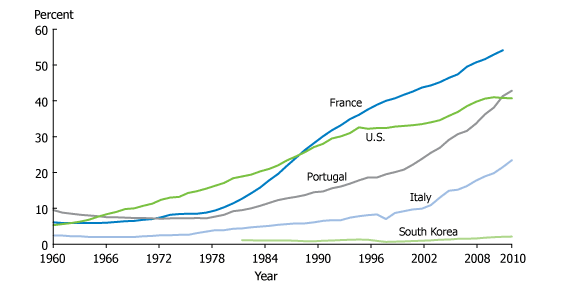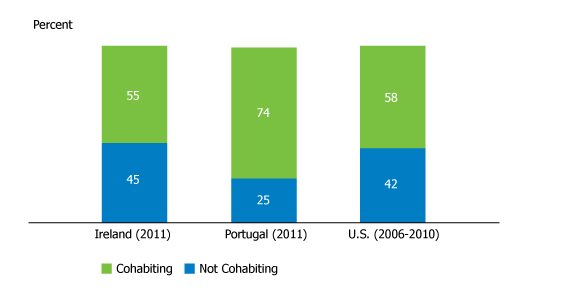Carl Haub
Former Demographer Emeritus

April 22, 2013
Former Demographer Emeritus
(April 2013) An important indication of changing attitudes toward family formation is the rapidly rising trend of births outside of marriage. Back in 1960, births outside of marriage were virtually unheard of and were often kept as secret as possible. Fifty years ago, people were expected to marry first and then start a family. Future grandparents often grew impatient waiting for that first grandchild.
Times have certainly changed. In many countries today, nonmarital childbearing has become routine. The pressure seems to be off, as the younger generation lives differently than earlier generations.
Percent of Births Outside Marriage, 1960-2008/2011, Selected Countries

Sources: EUROSTAT, Council of Europe, U.S. National Center for Health Statistics, national statistical offices.
Not surprisingly, more socially progressive countries, such as Sweden, have led the way in nontraditional forms of family formation. But ultimately, young parents in many other countries adopted similar lifestyles. In 2011, 40 percent of births in the European Union took place outside of traditional marriage. There are eight EU member countries where half or more of births are nonmarital: Belgium, Bulgaria, Estonia, France, Iceland, Slovenia, Norway, and Sweden. Iceland has the world’s highest proportion at 65 percent. Many other EU countries, as well as the United States, are not far behind. Such figures would have been astounding, virtually scandalous, back in the 1960s and 1970s when terms such as “unwed mother” or “illegitimate child” were commonly used.
Now, however, births outside of formal marriage occur to cohabiting couples who care for the child and maintain a household the same as their married counterparts. More than half of nonmarital births take place in a cohabiting household and minus any stigma of the past. Nonetheless, it has been surprising to many that this new pattern of childbearing has also taken place in countries where social and religious norms would seem to be against it: Ireland, Italy, Portugal, and Spain are examples.
Percent of Births Outside Marriage by Cohabiting Status

Sources: for Ireland: Central Statistical Office; for Portugal: PORDATA; for U.S.: National Vital Statistics Reports.
This trend has also taken place in countries where very low birth rates have been a national concern. Is it possible that more liberal attitudes toward the “marriage first, babies second” have helped keep birth rates at least where they are? Consider South Korea, where births outside marriage are quite rare. The country’s total fertility rate (TFR, or the average number of children per woman) is a low 1.2, of great concern for the government as it sees large future increases in pensions and health care for a rapidly aging population. Does the fact that couples appear to have to establish a married-couple household first pose problems for raising the national birth rate?
What we can say for certain is that this new household structure is quite unlikely to revert to times past.
Carl Haub is a senior demographer at the Population Reference Bureau.
